
Buddhist religious architecture developed in the Indian subcontinent. Three types of structures are associated with the religious architecture of early Buddhism: monasteries (viharas), places to venerate relics (stupas), and shrines or prayer halls (chaityas, also called chaitya grihas), which later came to be called temples in some places.
The initial function of a stupa was the veneration and safe-guarding of the relics of Gautama Buddha. The earliest archaeologically known example of a stupa is the relic stupa located in Vaishali, Bihar in India.[1][2]
In accordance with changes in religious practice, stupas were gradually incorporated into chaitya-grihas (prayer halls). These are exemplified by the complexes of the Ajanta Caves and the Ellora Caves (Maharashtra). The Mahabodhi Temple at Bodh Gaya in Bihar is another well-known example.
The pagoda is an evolution of the Indian stupas.
Early development in India
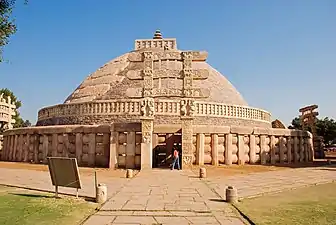
A characteristic new development at Buddhist religious sites was the stupa. Stupas were originally more sculpture than building, essentially markers of some holy site or commemorating a holy man who lived there. Later forms are more elaborate and also in many cases refer back to the Mount Meru model.
One of the earliest Buddhist sites still in existence is at Sanchi, India, and this is centred on a stupa said to have been built by King Ashoka (273–236 BCE). The original simple structure is encased in a later, more decorative one, and over two centuries the whole site was elaborated upon. The four cardinal points are marked by elaborate stone gateways.
As with Buddhist art, architecture followed the spread of Buddhism throughout south and east Asia and it was the early Indian models that served as a first reference point, even though Buddhism virtually disappeared from India itself in the 10th century.
Decoration of Buddhist sites became steadily more elaborate through the last two centuries BCE, with the introduction of tablets and friezes, including human figures, particularly on stupas. However, the Buddha was not represented in human form until the 1st century CE. Instead, aniconic symbols were used. This is treated in more detail in Buddhist art, Aniconic phase. It influenced the development of temples, which eventually became a backdrop for Buddha images in most cases.
As Buddhism spread, Buddhist architecture diverged in style, reflecting the similar trends in Buddhist art. Building form was also influenced to some extent by the different forms of Buddhism in the northern countries, practising Mahayana Buddhism in the main and in the south where Theravada Buddhism prevailed.
Regional Buddhist architecture
China
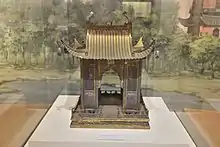
When Buddhism came to China, Buddhist architecture came along with it. There were many monasteries built, equaling about 45,000. These monasteries were filled with examples of Buddhist architecture, and because of this, they hold a very prominent place in Chinese architecture. One of the earliest surviving example is the brick pagoda at the Songyue Monastery in Dengfeng County.
Indonesia
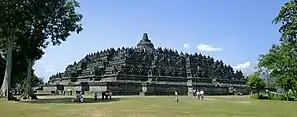
.jpg.webp)
Buddhism and Hinduism reach Indonesian archipelago in early first millennia. The oldest surviving temple structure in Java is Batujaya temples in Karawang, West Java, dated as early as 5th century.[3] The temple was a Buddhist sites, as evidence of the discovered Buddhist votive tablets, and the brick stupa structure.
The apogee of ancient Indonesian Buddhist art and architecture was the era of Javanese Shailendra dynasty that ruled the Mataram Kingdom in Central Java circa 8th to 9th century CE. The most remarkable example is the 9th century Borobudur, a massive stupa that took form of an elaborate stepped pyramid that took plan of stone mandala. The walls and balustrades are decorated with exquisite bas reliefs, covering a total surface area of 2,500 square metres. Around the circular platforms are 72 openwork stupas, each containing a statue of the Buddha.[4] Borobudur is recognised as the largest Buddhist temple in the world.[5]
Thailand
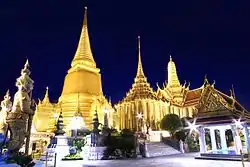
In Thailand, Buddhist temples are known as wat’s, from the Pāḷi vāṭa, meaning "enclosure." A wat usually consists of two parts: the Phutthawat (worship area dedicated to Buddha) and the Sangkhawat (monastery dedicated for Sangha).
Thai Buddhist temples usually contains golden chedi in the form of a bell-shaped stupa tower covered with gold leaf, containing a relic chamber. Another typical feature is Prang tower in the top center of the Buddhist temple structure. Thai Buddhist temples consists of several structures, including Ubosot (ordination hall), Wihan (vihara), Mondop (mandapa), Ho trai (library), and Sala (open pavilion), Ho rakhang (bell tower), and other supporting buildings.
All of those temple structures display multiple roof tiers. The use of ornamented tiers is reserved for roofs on temples, palaces and important buildings. Two or three tiers are most often used, but some royal temples have four.
Hawaii
Many of the Buddhist temples in Hawaii have an architectural style which is specific to the islands. Japanese immigrants who migrated to Hawaii did not have access to the same materials they would have in Japan, and the land structure called for different building techniques. Because these Japanese immigrants had all the knowledge of Buddhism and were exceptional craftsmen, these temples ended up being a good personification of their religion.
There are 5 styles of architecture that can be found in the Buddhist temples of Hawaii. The styles vary because of the time periods they were used in.[6]
Converted houses
This was the earliest form of Buddhist temples in Hawaii. They took a larger plantation house and converted them into places of worship by adding things like an altar or shrines. This style offered an inexpensive way to build temples, and using residential space made the worshipers feel more connected. This style dropped in popularity during the 20th century.[6]
Traditional Japanese
This style originated when Japanese immigrants with the existing skill of building temples and shrines moved to Hawaii. These were made to be similar to the original Japanese temples, but certain aspects had to be changed because of lesser access to materials and tools. Characteristics of this style are beam and post structure, elevated floors, and hip-and-gable roofs. The interiors had the same structure as their original counterparts in Japan.[6]
Simplified Japanese
This style originated with Japanese immigrants who did not have the greatest shrine and temple building skills. These immigrants still wanted the temples to have their original feel, but lacked the skill to do it, so the building techniques they used were simplified. Some characteristics of this style are straight hip-and-gable roofs, as opposed to the long, sloping ones, a separate social hall, and covered entryway. These temples doubled as community centers, and were similar in style to western churches.[6]
Indian Western
This style is unique to Hawaii, originating from Pan-Asian Buddhism, which was a combination of Indian, Japanese, and Western Buddhism. When the first temple of this style was built, the architects that were hired had no previous experience in Buddhist architecture. The style was popular up until the 1960s. It was one of the most popular styles of Buddhist architecture in Hawaii; smaller temples that could not afford to hire architects to do this to their temple would take certain aspects of this style and apply it to their temple. The interiors of these temples are very similar to the original temples in Japan.[6]
House of worship
This style is also very similar to western churches. It became popular in the 1960s. These temples are usually made of concrete, and the roof styles vary unlike the other styles of temples. The subcategories of this style are residential, warehouse, church, and Japanesque. Like the other styles, while the exterior is dramatically different, the interior mostly remained similar to the temples in Japan.[6]
Examples
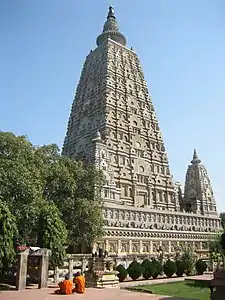 Mahabodhi temple, Gaya
Mahabodhi temple, Gaya
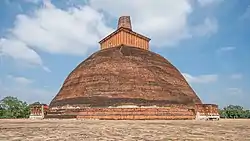 Jetavanaramaya stupa is an example of brick-clad Buddhist architecture in Sri Lanka
Jetavanaramaya stupa is an example of brick-clad Buddhist architecture in Sri Lanka
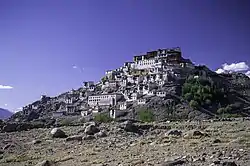
.jpg.webp) Tawang Monastery in Arunachal Pradesh, was built in the 1600s, is the largest monastery in India and second largest in the world after the Potala Palace in Lhasa, Tibet
Tawang Monastery in Arunachal Pradesh, was built in the 1600s, is the largest monastery in India and second largest in the world after the Potala Palace in Lhasa, Tibet
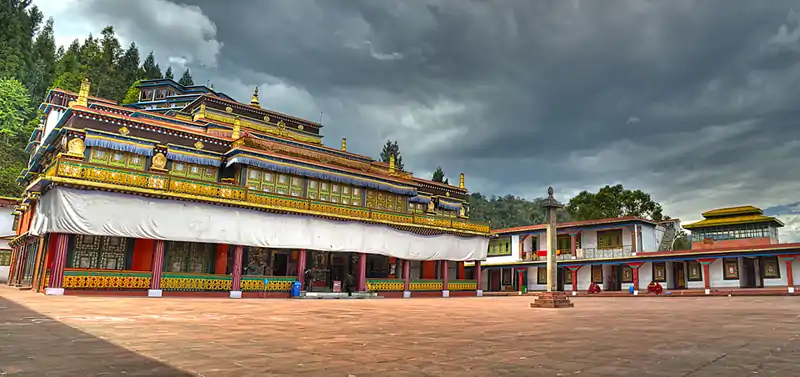 Rumtek Monastery in Sikkim was built under the direction of Changchub Dorje, 12th Karmapa Lama in the mid-1700s[7]
Rumtek Monastery in Sikkim was built under the direction of Changchub Dorje, 12th Karmapa Lama in the mid-1700s[7]

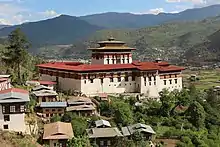 The Rinpung Dzong follows a distinctive type of fortress architecture found in the former and present Buddhist kingdoms of the Himalayas, most notably Bhutan
The Rinpung Dzong follows a distinctive type of fortress architecture found in the former and present Buddhist kingdoms of the Himalayas, most notably Bhutan
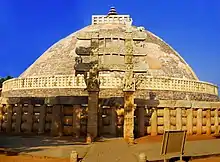 The Great Stupa in Sanchi, India is considered a cornerstone of Buddhist architecture
The Great Stupa in Sanchi, India is considered a cornerstone of Buddhist architecture
.JPG.webp) Mongolian statue of Avalokiteśvara (Mongolian name: Migjid Janraisig), Gandantegchinlen Monastery. Tallest indoor statue in the world, 26.5-meter-high, 1996 rebuilt, (1913)
Mongolian statue of Avalokiteśvara (Mongolian name: Migjid Janraisig), Gandantegchinlen Monastery. Tallest indoor statue in the world, 26.5-meter-high, 1996 rebuilt, (1913).jpg.webp)

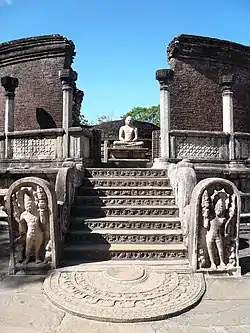 Vatadage Temple, in Polonnaruwa, is a uniquely Sri Lankan circular shrine enclosing a small dagoba. The vatadage has a three-tiered conical roof, spanning a height of 40–50 feet, without a center post, and supported by pillars of diminishing height
Vatadage Temple, in Polonnaruwa, is a uniquely Sri Lankan circular shrine enclosing a small dagoba. The vatadage has a three-tiered conical roof, spanning a height of 40–50 feet, without a center post, and supported by pillars of diminishing height
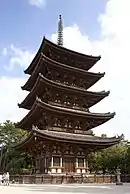

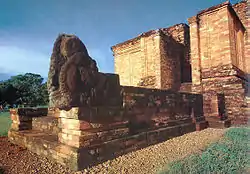
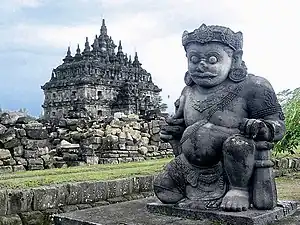 Plaosan temple
Plaosan temple
 Minar-i Chakri in 1836, Afghanistan
Minar-i Chakri in 1836, Afghanistan
 A painting by G.B. Hooijer (c. 1916–1919) reconstructing the scene of Borobudur during its heyday
A painting by G.B. Hooijer (c. 1916–1919) reconstructing the scene of Borobudur during its heyday

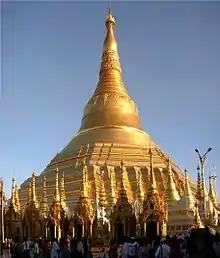 Shwedagon Pagoda, Myanmar
Shwedagon Pagoda, Myanmar
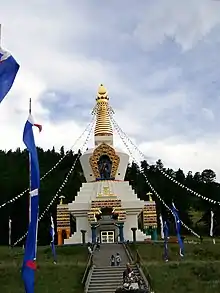 Great Stupa at Shambhala Mountain Center, United States
Great Stupa at Shambhala Mountain Center, United States
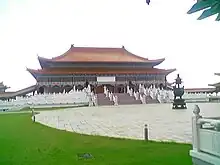 Nan Hua Main Temple, South Africa
Nan Hua Main Temple, South Africa
 Golden Temple of Shakyamuni Buddha, Kalmykia, Russian Federation
Golden Temple of Shakyamuni Buddha, Kalmykia, Russian Federation

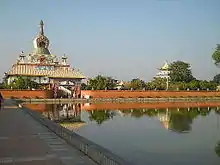
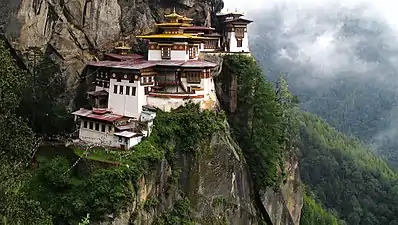
See also
References
- ↑ Fogelin, Lars (2015). An Archaeological History of Indian Buddhism. Oxford University Press. p. 85. ISBN 9780199948239.
- ↑ Lahiri, Nayanjot (2015). Ashoka in Ancient India. Harvard University Press. pp. 246–247. ISBN 9780674057777.
- ↑ "Batujaya Temple (West Java) - Temples of Indonesia". candi.perpusnas.go.id. Archived from the original on 2021-03-02. Retrieved 2020-08-09.
- ↑ "Borobudur Temple Compounds". UNESCO World Heritage Centre. Archived from the original on 2021-05-30. Retrieved 2020-08-09.
- ↑ "Largest Buddhist temple". Guinness World Records. Archived from the original on 2020-07-20. Retrieved 2020-08-09.
- 1 2 3 4 5 6 “Architecture and Interiors.” Japanese Buddhist Temples in Hawai‘i: An Illustrated Guide, by George J. Tanabe and Wills Jane Tanabe, University of Hawai'i Press, 2013, pp. 17–42. JSTOR, www.jstor.org/stable/j.ctt6wqfvf.6.
- ↑ Achary Tsultsem Gyatso; Mullard, Saul & Tsewang Paljor (Transl.): A Short Biography of Four Tibetan Lamas and Their Activities in Sikkim, in: Bulletin of Tibetology Nr. 49, 2/2005, p. 57.
External links
 Media related to Buddhist architecture at Wikimedia Commons
Media related to Buddhist architecture at Wikimedia Commons- Peabody Essex Museum – Phillips Library: The Herbert Offen Research Collection – books and items on Buddhist architecture.